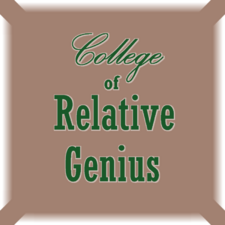College of Relative Genius
College of Relative Genius
51 2nd Street, Shostakovich
Industry: Education
Entity type: Non-profit, public
Product: Secondary education
Specialties: Peacekeeping arts, climatic and meteorological sciences, athletic arts
Enrollment: 23,200
Revenue (CRRS): J
Colors: Parsley, Pharlap
College of Relative Genius (CRG) is a public institution of secondary education located in the city of Shostakovich. CRG offers secondary degrees in a variety of liberal arts and sciences disciplines, but is best known for its strong programs in the peacekeeping arts, climatic and meteorological sciences, and athletic arts.
The College of Relative Genius attracts most of its students locally and regionally from interior of the River Harmonica region. Many students from the Harmony metropolitan area are attracted by CRG's peacekeeping, meteorological, and athletic programs. Graduates from CRG frequently become successful mediators, meteorologists, and sportsball athletes. Most secondary graduates go on to pursue tertiary studies in the human and cultural arts and sciences. The college's students, as is the case with students attending all public education institutions, enjoy a nearly 100% placement rate upon graduation thanks to the Occupational and Instructional Productivity and Placement System (OIPPS) which is administered by the Office of Assessment and Placement (OAP).
The college's enrollment totals 23,200 students. The College of Relative Genius receives funding from the Bureau of Education and Enlightenment (BEE) proportional to its student population, and its curriculum is under the oversight of the BEE's Office of Curriculum and Programming (OCP). As with most public educational institutions, public funding accounts for nearly all of CRG's operational resources. The university's annual revenue averages 2,560,000μ annually.
CRG is known for its student club which cultivates muscular and athletic meat plant specimens and then sells them at a periodic market to fundraise for students' recreational endeavors.
